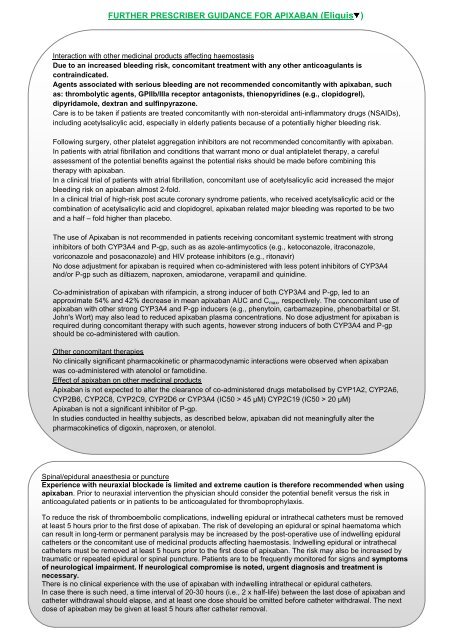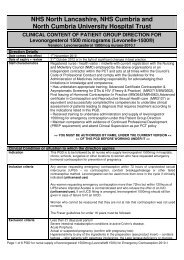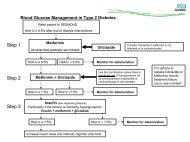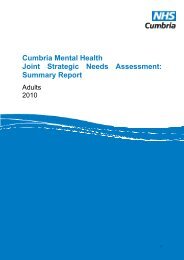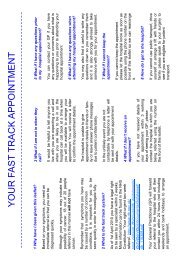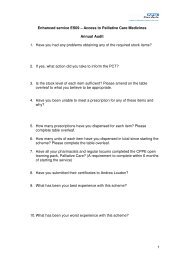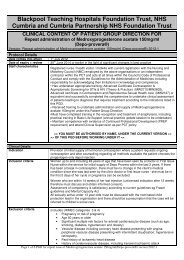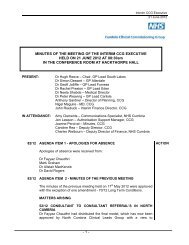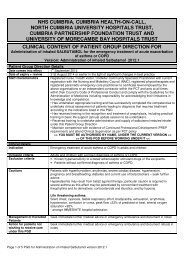Prescribing Guidance for NOACs - NHS Cumbria
Prescribing Guidance for NOACs - NHS Cumbria
Prescribing Guidance for NOACs - NHS Cumbria
Create successful ePaper yourself
Turn your PDF publications into a flip-book with our unique Google optimized e-Paper software.
FURTHER PRESCRIBER GUIDANCE FOR APIXABAN (Eliquis )Interaction with other medicinal products affecting haemostasisDue to an increased bleeding risk, concomitant treatment with any other anticoagulants iscontraindicated.Agents associated with serious bleeding are not recommended concomitantly with apixaban, suchas: thrombolytic agents, GPIIb/IIIa receptor antagonists, thienopyridines (e.g., clopidogrel),dipyridamole, dextran and sulfinpyrazone.Care is to be taken if patients are treated concomitantly with non-steroidal anti-inflammatory drugs (NSAIDs),including acetylsalicylic acid, especially in elderly patients because of a potentially higher bleeding risk.Following surgery, other platelet aggregation inhibitors are not recommended concomitantly with apixaban.In patients with atrial fibrillation and conditions that warrant mono or dual antiplatelet therapy, a carefulassessment of the potential benefits against the potential risks should be made be<strong>for</strong>e combining thistherapy with apixaban.In a clinical trial of patients with atrial fibrillation, concomitant use of acetylsalicylic acid increased the majorbleeding risk on apixaban almost 2-fold.In a clinical trial of high-risk post acute coronary syndrome patients, who received acetylsalicylic acid or thecombination of acetylsalicylic acid and clopidogrel, apixaban related major bleeding was reported to be twoand a half – fold higher than placebo.The use of Apixaban is not recommended in patients receiving concomitant systemic treatment with stronginhibitors of both CYP3A4 and P-gp, such as as azole-antimycotics (e.g., ketoconazole, itraconazole,voriconazole and posaconazole) and HIV protease inhibitors (e.g., ritonavir)No dose adjustment <strong>for</strong> apixaban is required when co-administered with less potent inhibitors of CYP3A4and/or P-gp such as diltiazem, naproxen, amiodarone, verapamil and quinidine.Co-administration of apixaban with rifampicin, a strong inducer of both CYP3A4 and P-gp, led to anapproximate 54% and 42% decrease in mean apixaban AUC and C max , respectively. The concomitant use ofapixaban with other strong CYP3A4 and P-gp inducers (e.g., phenytoin, carbamazepine, phenobarbital or St.John's Wort) may also lead to reduced apixaban plasma concentrations. No dose adjustment <strong>for</strong> apixaban isrequired during concomitant therapy with such agents, however strong inducers of both CYP3A4 and P-gpshould be co-administered with caution.Other concomitant therapiesNo clinically significant pharmacokinetic or pharmacodynamic interactions were observed when apixabanwas co-administered with atenolol or famotidine.Effect of apixaban on other medicinal productsApixaban is not expected to alter the clearance of co-administered drugs metabolised by CYP1A2, CYP2A6,CYP2B6, CYP2C8, CYP2C9, CYP2D6 or CYP3A4 (IC50 > 45 μM) CYP2C19 (IC50 > 20 μM)Apixaban is not a significant inhibitor of P-gp.In studies conducted in healthy subjects, as described below, apixaban did not meaningfully alter thepharmacokinetics of digoxin, naproxen, or atenolol.Spinal/epidural anaesthesia or punctureExperience with neuraxial blockade is limited and extreme caution is there<strong>for</strong>e recommended when usingapixaban. Prior to neuraxial intervention the physician should consider the potential benefit versus the risk inanticoagulated patients or in patients to be anticoagulated <strong>for</strong> thromboprophylaxis.To reduce the risk of thromboembolic complications, indwelling epidural or intrathecal catheters must be removedat least 5 hours prior to the first dose of apixaban. The risk of developing an epidural or spinal haematoma whichcan result in long-term or permanent paralysis may be increased by the post-operative use of indwelling epiduralcatheters or the concomitant use of medicinal products affecting haemostasis. Indwelling epidural or intrathecalcatheters must be removed at least 5 hours prior to the first dose of apixaban. The risk may also be increased bytraumatic or repeated epidural or spinal puncture. Patients are to be frequently monitored <strong>for</strong> signs and symptomsof neurological impairment. If neurological compromise is noted, urgent diagnosis and treatment isnecessary.There is no clinical experience with the use of apixaban with indwelling intrathecal or epidural catheters.In case there is such need, a time interval of 20-30 hours (i.e., 2 x half-life) between the last dose of apixaban andcatheter withdrawal should elapse, and at least one dose should be omitted be<strong>for</strong>e catheter withdrawal. The nextdose of apixaban may be given at least 5 hours after catheter removal.


